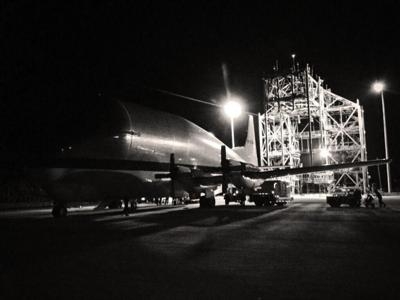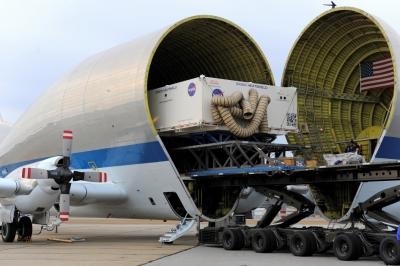Fri, Dec 06, 2013
Largest Such Device Ever Built
NASA's Orion spacecraft is just about ready to turn up the heat. The spacecraft's heat shield arrived at the agency's Kennedy Space Center in Florida Wednesday night aboard the agency's Super Guppy aircraft. The heat shield, the largest of its kind ever built, is to be unloaded Thursday and is scheduled for installation on the Orion crew module in March, in preparation for Orion's first flight test in September 2014.

"The heat shield completion and delivery to Kennedy, where Orion is being prepared, is a major step toward Exploration Flight Test-1 next year," said Dan Dumbacher, NASA's deputy associate administrator for exploration systems development in Washington. "Sending Orion into space for the first time is going to give us crucial data to improve our design decisions and develop Orion to send humans on future missions to an asteroid and Mars."
The heat shield began its journey in January 2012 in Colorado, at Orion prime contractor Lockheed Martin's Waterton Facility near Denver. That was the manufacturing site for a titanium skeleton and carbon fiber skin that give the heat shield its shape and provide structural support during landing. They were shipped in March to Textron Defense Systems near Boston, where they were used in construction of the heat shield itself.
Textron installed a fiberglass-phenolic honeycomb structure on the skin, filled each of the honeycomb's 320,000 cells with the ablative material Avcoat, then X-rayed and sanded each cell to match Orion's design specifications. The Avcoat-treated shell will shield Orion from the extreme heat it will experience as it returns to Earth. The ablative material will wear away as it heats up during Orion's re-entry into the atmosphere, preventing heat from being transferred to the rest of the capsule. "Many people across the country have poured a tremendous amount of hard work into building this heat shield," said Orion Program Manager Mark Geyer. "Their efforts are a critical part of helping us understand what it takes to bring a human-rated spacecraft back safely from deep space."

Before and during its manufacture, the heat shield material was subjected to arc-jet testing NASA's Ames Research Center in California and NASA's Johnson Space Center in Houston. Arc jets heat and expand gasses to very high temperatures and supersonic and hypersonic speeds, thus simulating the heating conditions that a returning spacecraft will experience.
The heat shield delivered to Kennedy will be used during Exploration Flight Test-1, a two-orbit flight that will take an uncrewed Orion capsule to an altitude of 3,600 miles. The returning capsule is expected to encounter temperatures of almost 4,000 degrees Fahrenheit as it travels through Earth's atmosphere at up to 20,000 mph, faster than any spacecraft in the last 40 years.
Data gathered during the flight will influence decisions about design improvements on the heat shield and other Orion systems, authenticate existing computer models, and innovative new approaches to space systems and development. It also will reduce overall mission risks and costs for future Orion missions, which include exploring an asteroid and Mars.
(Images provided by NASA)
More News
Omnidirectional Approach Lighting System ODALS consists of seven omnidirectional flashing lights located in the approach area of a nonprecision runway. Five lights are located on t>[...]
"Polaris Dawn, the first of the program’s three human spaceflight missions, is targeted to launch to orbit no earlier than summer 2024. During the five-day mission, the crew >[...]
Also: 1800th E-Jet, Uncle Sam Sues For Landing Gear, Embraer Ag Plane, Textron Parts A friend of the family reported that Lt. Col. (Ret.) Richard Glenn Rutan flew west on Friday, M>[...]
Also: Virgin Galactic, B-29 Doc to Allentown, Erickson Fire-Fighters Bought, FAA Reauthorization After dealing with a big letdown after the unexpected decision by Skyreach to disco>[...]
“Our aircrews are trained and capable of rapidly shifting from operational missions to humanitarian roles. We planned to demonstrate how we, and our BORSTAR partners, respond>[...]
 ANN's Daily Aero-Term (05.05.24): Omnidirectional Approach Lighting System
ANN's Daily Aero-Term (05.05.24): Omnidirectional Approach Lighting System Aero-News: Quote of the Day (05.05.24)
Aero-News: Quote of the Day (05.05.24) Airborne 05.06.24: Gone West-Dick Rutan, ICON BK Update, SpaceX EVA Suit
Airborne 05.06.24: Gone West-Dick Rutan, ICON BK Update, SpaceX EVA Suit Airborne 05.03.24: Advanced Powerplant Solutions, PRA Runway Woes, Drone Racing
Airborne 05.03.24: Advanced Powerplant Solutions, PRA Runway Woes, Drone Racing Aero-News: Quote of the Day (05.06xx.24)
Aero-News: Quote of the Day (05.06xx.24)




